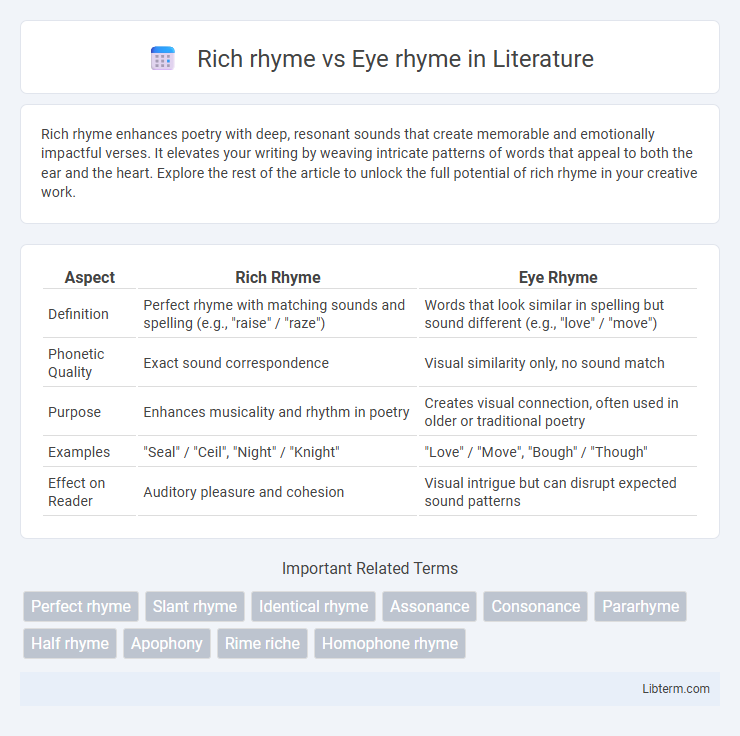Rich rhyme enhances poetry with deep, resonant sounds that create memorable and emotionally impactful verses. It elevates your writing by weaving intricate patterns of words that appeal to both the ear and the heart. Explore the rest of the article to unlock the full potential of rich rhyme in your creative work.
Table of Comparison
| Aspect | Rich Rhyme | Eye Rhyme |
|---|---|---|
| Definition | Perfect rhyme with matching sounds and spelling (e.g., "raise" / "raze") | Words that look similar in spelling but sound different (e.g., "love" / "move") |
| Phonetic Quality | Exact sound correspondence | Visual similarity only, no sound match |
| Purpose | Enhances musicality and rhythm in poetry | Creates visual connection, often used in older or traditional poetry |
| Examples | "Seal" / "Ceil", "Night" / "Knight" | "Love" / "Move", "Bough" / "Though" |
| Effect on Reader | Auditory pleasure and cohesion | Visual intrigue but can disrupt expected sound patterns |
Understanding Rich Rhyme: Definition and Features
Rich rhyme involves the repetition of identical sounds in both vowel and consonant elements, creating a perfect phonetic match, such as "raise" and "raze." This technique requires the rhymed words to share the same pronunciation, enhancing auditory harmony and depth in poetry or lyric writing. Understanding rich rhyme highlights its rarity and sophistication compared to eye rhyme, which relies on similar spelling rather than sound.
What is Eye Rhyme? Key Characteristics
Eye rhyme, also known as visual rhyme, involves words that appear to rhyme based on their spelling but do not produce a matching sound when spoken, such as "love" and "move." Key characteristics include similar letter patterns, often at the end of words, that deceive the reader into expecting a phonetic rhyme. Eye rhyme is commonly used in poetry to create visual symmetry without relying on auditory rhyme, contrasting with rich rhyme which depends on identical or nearly identical sounds.
Historical Origins of Rich and Eye Rhymes
Rich rhyme, characterized by identical sounds or homophones, traces its origins to Old English poetry where phonetic exactness emphasized sound harmony and memorability. Eye rhyme emerged in Middle English due to the Great Vowel Shift, creating pairs of words like "love" and "move" that appear similar visually but differ phonetically. Both rhyme types reflect linguistic evolutions shaped by historical sound changes and orthographic conventions in English literature.
How Rich Rhymes Enhance Poetic Sound
Rich rhymes intensify poetic sound by pairing words with both identical sounds and meanings, creating a deeper resonant effect that engages the listener beyond mere phonetic similarity. Unlike eye rhymes, which rely solely on visual spelling congruence without matching sounds, rich rhymes amplify auditory cohesion and emotional impact in poetry. This multifaceted connection enriches the texture of verses, contributing to a more immersive and sonically pleasing reading experience.
The Visual Trickery of Eye Rhymes in Literature
Eye rhymes create visual similarity between words that do not share identical sounds, such as "love" and "move," generating a unique interplay between spelling and pronunciation in literature. This form of rhyming captivates readers by exploiting orthographic resemblance to evoke expectations that challenge auditory perception, enriching poetic texture and interpretive depth. Contrastingly, rich rhymes rely on identical sounds extending beyond the rhyme syllable, emphasizing phonetic harmony and resonance rather than visual deception.
Comparing Auditory Impact: Rich Rhyme vs Eye Rhyme
Rich rhyme produces a stronger auditory impact by matching both vowel and consonant sounds precisely, creating a full and harmonious echo that enhances the poem's musicality. Eye rhyme relies on visual similarity in spelling without phonetic matching, often leading to a weaker or unexpected sound connection when read aloud. The contrasting effects influence how readers perceive rhythm and sound, with rich rhyme offering a more immersive acoustic experience compared to the subtle or sometimes jarring cues of eye rhyme.
Rich Rhyme and Eye Rhyme in Classic Poetry
Rich rhyme involves words that sound identical in their stressed vowels and subsequent sounds, often including homonyms or homophones, creating a strong auditory connection in classic poetry. Eye rhyme relies on spelling similarities rather than pronunciation, where words appear to rhyme visually but differ phonetically, a technique frequently observed in Shakespearean sonnets. The use of rich rhyme enhances musicality and cohesion, while eye rhyme adds subtlety and visual resonance in traditional poetic structures.
Modern Usage: Rich and Eye Rhyme in Contemporary Writing
Rich rhyme in contemporary writing enhances poetic expression by pairing words with identical sounds and meanings, creating a deeper auditory and semantic harmony. Eye rhyme, often used for visual effect, relies on similar spelling but different sounds, adding a subtle layer of complexity and surprise in modern poetry and lyrics. Both forms serve distinct artistic purposes, enriching the texture and emotional impact of contemporary verse.
Tips for Choosing the Right Rhyme for Your Poem
Rich rhyme involves matching sounds with words sharing identical phonetic elements, creating a deeper auditory connection, while eye rhyme relies on similar spelling but differing pronunciation. When choosing the right rhyme for your poem, consider your poem's tone and rhythm, opting for rich rhymes to enhance musicality and emotional impact, or eye rhymes to introduce subtle visual interest and complexity. Experiment with rhyme types to balance sound and sight, aligning with your poem's thematic goals and desired reader engagement.
Common Mistakes with Rich and Eye Rhymes to Avoid
Common mistakes with rich rhymes include forcing unrelated words to fit the rhyme scheme, leading to awkward or unnatural phrasing that disrupts the poem's flow. With eye rhymes, writers often rely too heavily on visual similarity without ensuring phonetic compatibility, resulting in jarring or false rhyme impressions. Avoid these pitfalls by prioritizing natural sound harmony in rich rhymes and verifying true phonetic correspondence in eye rhymes to maintain lyrical coherence.
Rich rhyme Infographic

 libterm.com
libterm.com